
-
Find the right food for your pet
Take this quiz to see which food may be the best for your furry friend.
Find the right food for your pet
Take this quiz to see which food may be the best for your furry friend.
Featured products
 Adult 7+ No Corn, Wheat, Soy Chicken & Brown Rice Dog Food
Adult 7+ No Corn, Wheat, Soy Chicken & Brown Rice Dog FoodSupports energy level and beautiful coat in mature dogs
Shop Now Adult 7+ Perfect Digestion Chicken, Whole Oats & Brown Rice Recipe Dog Food
Adult 7+ Perfect Digestion Chicken, Whole Oats & Brown Rice Recipe Dog FoodScience Diet's breakthrough nutrition supports ultimate digestive well-being & healthy microbiome for dogs age 7+
Shop Now Adult Perfect Weight & Joint Support Chicken Recipe Dry Dog Food
Adult Perfect Weight & Joint Support Chicken Recipe Dry Dog FoodThis weight management and mobility support dog food was created with Hill’s unique understanding of the biology of overweight dogs.
Shop NowFeatured products
 Adult Savory Chicken Entrée Cat Food
Adult Savory Chicken Entrée Cat FoodPrecisely balanced nutrition with the delicious taste of savory minced chicken to help fuel the energy needs of cats during the prime of their life
Shop Now Adult Perfect Digestion Chicken, Barley & Whole Oats Recipe Cat Food
Adult Perfect Digestion Chicken, Barley & Whole Oats Recipe Cat FoodScience Diet's breakthrough nutrition supports ultimate digestive well-being & healthy microbiome
Shop Now Perfect Weight Salmon & Vegetable Canned Cat Food
Perfect Weight Salmon & Vegetable Canned Cat FoodOver 70% of cats lost weight within 10 weeks when fed this nutrition
Shop Now -
Dog
- Dog Tips & Articles
-
Health Category
- Weight
- Food & Environmental Sensitivities
- Urinary
- Digestive
- Joint
- Kidney
-
Life Stage
- Puppy Nutrition
- Adult Nutrition
- Senior Nutrition
Cat
- Cat Tips & Articles
-
Health Category
- Weight
- Skin & Food Sensitivities
- Urinary
- Digestive
- Kidney
-
Life Stage
- Kitten Nutrition
- Adult Nutrition
Featured articles
 The Incredible Science Behind Your Pet's Microbiome
The Incredible Science Behind Your Pet's MicrobiomeLearn what a pet's microbiome is, how it contributes to your pet's gut & overall health, and why nutrition is important in maintaining healthy microbiomes.
Read More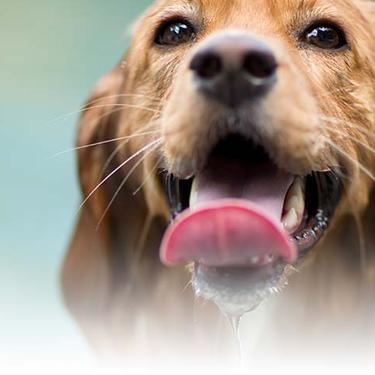 Water
WaterDiscover why water is the most important nutrient for your dog or cat to live a healthy life. Find out how much water your pet should consume each day.
Read More Pet Food Storage Tips
Pet Food Storage TipsDiscover how and where to store your dry, as well as canned, dog and cat food. Learn how to find the "best before" dates on all Hill's pet food packaging.
Read More -
Find the right food for your pet
Find the right food for your pet

If your heart's been captured by a dog or cat who has three legs, you might wonder whether you'll be able to provide the care they need. How will they get around? Will they need special equipment, like a three-legged dog harness?
Here's what to expect when adopting a three-legged pet.
Three-Legged Pets
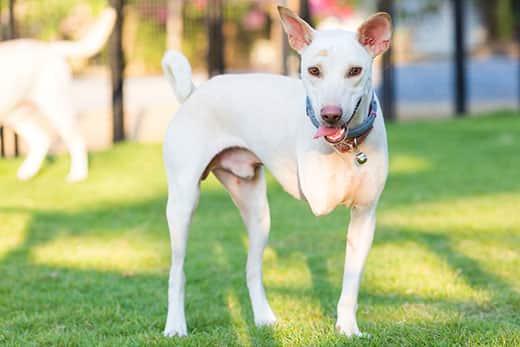
Since dogs and cats tend to live in the moment and easily accept and adapt to new situations, they generally handle amputations in stride. In fact, Petful points out, pet amputations are usually more upsetting for pet parents than for the pets themselves.
With the source of their pain or illness gone, animals tend to quickly adapt to losing a leg. Often, they regain full mobility in a short amount of time — though they may need help on stairs and uneven ground, as well as additional assistance as they age. But by keeping them at a healthy weight and paying special attention to joint health, you can ensure that your three-legged pet remains mobile and active well into old age.
Questions to Ask Before Adopting a Three-Legged Cat or Dog
When considering adopting any pet, it's important to ask questions about their breed, temperament, exercise and grooming needs, etc. Get answers to these additional questions specific to "tri-pawed" pets so that you'll have a better idea of what to expect when adopting a three-legged pet:
- How old are they? Do they have joint problems or other age-related issues that can affect mobility?
- What was the reason for their amputation? If it was a disease, such as cancer, you might consider researching the condition to see if it can come back and signs to look out for. Some conditions may even require certain therapeutic nutrition such as ones formulated for proper weight. If you do decide to adopt a three-legged bundle of joy, remember to always consult a veterinarian before beginning any special therapeutic foods or supplements.
- Are they missing a front or back leg? "Dogs carry 60 percent of their weight on their front legs," says the Best Friends Animal Society, so if a dog is missing their front leg, it's important to limit strain on the remaining front limb. Dogs missing a front leg and older three-legged pets might need a four-wheeled dog wheelchair or a three-legged dog harness.
- Does the pet require any type of pain management? While most three-legged cats and dogs are fully healed by the time they're placed for adoption, some may have ongoing pain that will need to be addressed. Pain management may include a combination of medicine, physical therapy and/or a heated pet bed. Speak to the shelter staff about the pain and then consult your veterinarian after adoption on the best course of treatment.
Preparing Your Home for a Three-Legged Pet
Before bringing your new pet home, spend time making some of these simple modifications to your house:
- Place rugs or carpet runners along hardwood floors, tile floors and other slick surfaces. This will make it easier for dogs and cats to safely walk around.
- Block off shelves, tops of refrigerators and other high places where cats might be tempted to jump. Cats with disabilities can wind up hurting themselves trying to get up to or down from high places. Consider providing a low cat tree so that your kitty can perch somewhere without climbing too high. Even with three legs, cats can be great jumpers.
- Before bringing a three-legged pet home, be sure windows are closed (if you have a cat or small dog) and block off access to balconies and other outdoor spaces. Plan to keep your three-legged dog or cat indoors, where they'll be safe from potential hazards such as animals or other pets looking for a fight.
- If you have a larger dog, use a stand to raise their food and water dishes, so they won't have to stoop to reach them. Stooping could cause a larger three-legged dog to lose their balance.
- Get your pet thick, well-padded orthopedic bedding to cushion the site of the amputation and make them more comfortable.
- For a cat, choose a litter box with low sides and place it somewhere they can step in without having to jump or climb.
- For a cat or small dog, consider placing a ramp or steps in front of your bed or couch to make it easier for them to get up — if you want to allow them there, of course.
Making some of these adjustments in your home will make it much easier for your pet to adjust to their new surroundings.


Tasty Tips
Long-Term Care
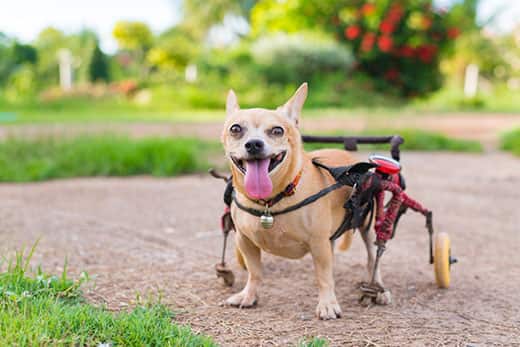
Are you wondering what to expect when adopting a three-legged pet who's older? The needs of a three-legged dog or cat, as with any pet, will change as they age. But you can help them maintain their mobility over their lifetime by being vigilant about their weight and joint health.
Here's where to focus your long-term care efforts:
- Regular exercise: It's extremely important for three-legged pets to have strong core muscles — for good balance, and so they don't put too much weight on their remaining legs, says Tripawds For dogs, short walks a few times a day are easier for them and more effective than long walks. Swimming is also an excellent exercise for pets with missing limbs, as it takes pressure off their joints — just make sure to keep them in shallower waters. Allowing dogs to run and play in your backyard or the dog park is also a great form of exercise. As for cats, Catstersuggests teasing them with a feather toy to encourage them to rise up on their hind legs, strengthening them in the process, or to have them use a wobble board or balance disc. Whatever the exercise is, be ready to stop when your pet seems tired.
- Weight management: While it's important for any pet to maintain a healthy weight, it's crucial for three-legged pets to avoid carrying extra pounds that will put pressure on their joints and leg muscles. In addition to regular exercise, be careful not to overfeed your pet — no matter how tempted you might be to spoil your sweet kitty or pup. Talk to your veterinarian to see if a therapeutic pet food formulated for weigh, mobility or both might be right for your three-legged friend.
- Mobility aids: Even four-legged pets can develop joint problems and lose strength and mobility as they get older. If it becomes harder for your three-legged pet to get around,consider using a three-legged dog harness with a handle to help with things like relieving themselves or going up and down stairs. For larger, heavier dogs, or for pets with more severe mobility loss, a pet wheelchair might become necessary. While this might sound drastic, pets tend to adapt quickly to using wheels and can often zip and zoom as well as any other pet.
Now that you have a better idea of what to expect when adopting a three-legged pet, you hopefully see that caring for one isn't all that different from caring for a pet with four legs. Three-legged pets have just as much love to give and can experience just as much joy as any other dog or cat.


Jean Marie Bauhaus is a pet parent, pet blogger, and novelist from Tulsa, Oklahoma, where she usually writes under the supervision of a lapful of fur babies.
Related products

This weight management and mobility support dog food was created with Hill’s unique understanding of the biology of overweight dogs.

Delicious braised beef paired with tender vegetables in a succulent stew

Science Diet's breakthrough nutrition supports ultimate digestive well-being & healthy microbiome for dogs age 7+

Supports energy level and beautiful coat in mature dogs
Related articles
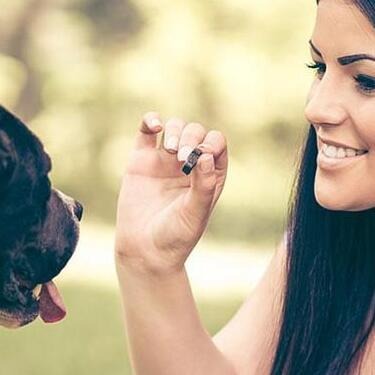
Proper nutrition for your pregnant or nursing dog is vital to her and her puppy's health. Learn what you should do provide her with the proper nutrients.
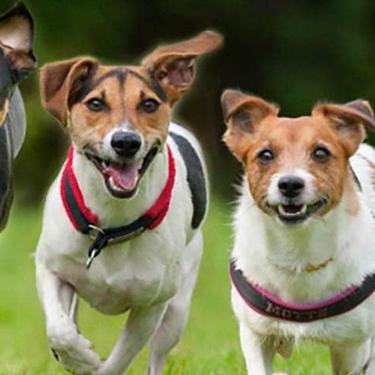
Learn about Hill's puppy food and the nutritional benefit & high quality ingredients that it contains for your pup.

Large and giant breed puppies have different nutritional needs than other dogs. Learn how to provide the special care they need to grow up big and strong.

Understand the role that Omega-6 and Omega-3 fatty acids play in your dog's overall health, and how you can ensure they are getting enough.

Put your dog on a diet without them knowing
Our low calorie formula helps you control your dog's weight. It's packed with high-quality protein for building lean muscles, and made with purposeful ingredients for a flavorful, nutritious meal. Clinically proven antioxidants, Vitamin C+E, help promote a healthy immune system.
Put your dog on a diet without them knowing
Our low calorie formula helps you control your dog's weight. It's packed with high-quality protein for building lean muscles, and made with purposeful ingredients for a flavorful, nutritious meal. Clinically proven antioxidants, Vitamin C+E, help promote a healthy immune system.

